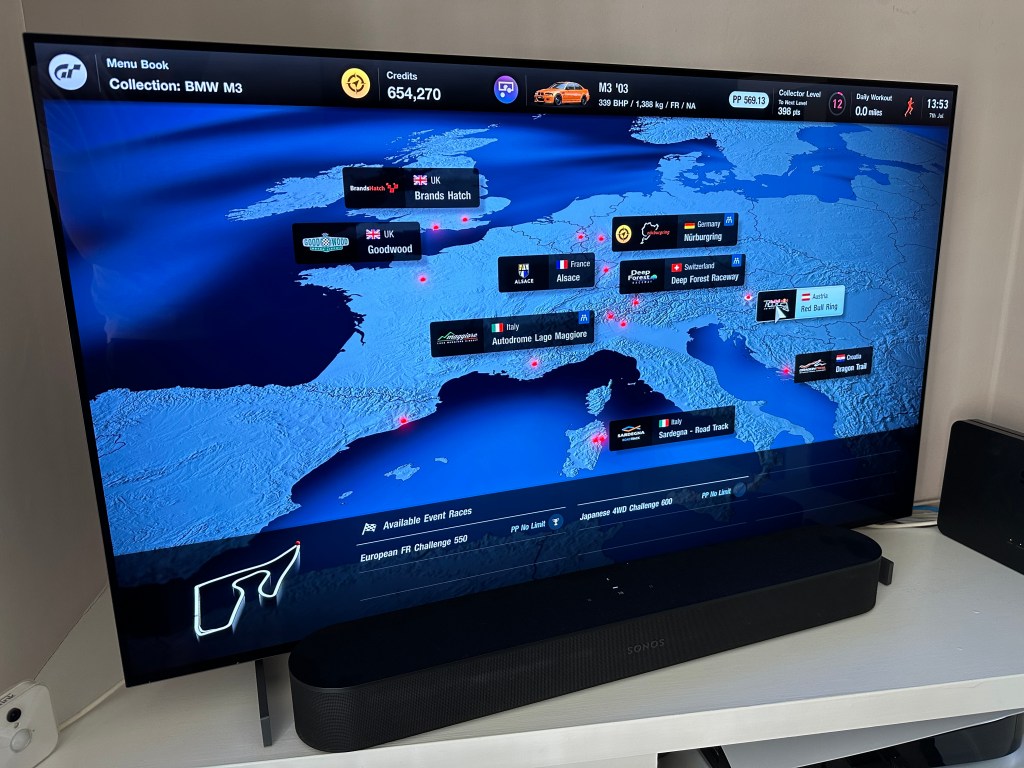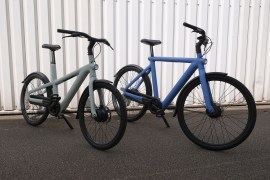Space race: how to build the ultimate compact console driving rig
With limited space to play with, can you still assemble a serious racing set up? And will it help improve your racecraft?

Sometimes being an adult is rubbish. Sure, you can have crisps for dinner if you can’t be bothered to cook, you get to vote for whichever chump you want in charge of the country, and you can stay up late playing video games and nobody can tell you off, but there are downsides too.
As much as I’d love to go full Richie Rich and turn my spare room into an arcade in order to do the latter in style, instead it’s full of boring grown-up stuff like my desk, a sofa bed, and drawers stuffed with life admin. So when I want to play racing games on my PS5 it’s on the sofa with a control pad in my hand, not in a full simulator rig with a bottle of champagne on standby for when I win my first championship.
But what if there’s another way? With copies of F1 23, Gran Turismo 7 and Dirt Rally 2.0 lined up on the grid, I set out to find a collection of kit that would let me play racing games properly without having to convert the living room into a full-time nerd bunker, and on a budget that’s more Aldi than Ferrari.
This is the ultimate driving setup for the spatially challenged gamer.
The chair: Playseat Challenge



With its metal frame that folds down to about the size of an ironing board, the Playseat Challenge (£199/$250) looks a bit like something you’d take for a long day sitting on the river bank. But if it’s tenths you’re fishing for rather than tench, this racing chair is ideal for anyone who doesn’t have a lounge the size of a Formula 1 pit garage.
It took me about 15 minutes to put the Playseat together, but it’s only really a case of slotting in the headrest, securing the seat with the heavy duty Velcro straps, and inserting the (slightly stubborn) pivoting metal platform for your steering wheel. A raised bar at the end of the pedal mount stops them sliding away when you stamp on the brakes, but there’s also a separate strap included in the box for holding them in place laterally – it looks a bit DIY but does the job.
By default the seating position is slightly reclined but still fairly upright, a bit like a bucket seat you’d find in a high-performance car, but it’s easy to loosen off the straps on either side for a lower, more laid back, F1-style driving position.
The actual cockpit of a racing car is often a hot, sweaty, uncomfortable place to be, but you could almost fall asleep in the Playseat Challenge. The ActiFit fabric is thick and spongy but still breathable, so you can do lap after lap in it without overheating. It’s worth putting it on a mat first, though, because otherwise it will leave fairly noticeable indents in your carpet.
Playseat’s instructions show the Challenge being folded up with the steering wheel and pedals still attached, but doing that is unwieldy, especially with all the wires trailing off it. Take them off, though, and it folds down pretty much flat, which makes it much easier to stash in a cupboard, under a bed, or behind the sofa when you’re not racing. Or fishing.
The controls: Logitech G923



Back in the early ‘90s Saab developed a car that was controlled by a joystick, but there’s a good reason we’re still using steering wheels – it was rubbish.
It’s possible to spend upwards of $1000 on a wheel and pedals to replace your console’s pad, but if you’re a more casual racer Logitech’s G923 (£349/$350), which is available for PlayStation, Xbox and PC, offers a good balance between price and features.
Clamp the wheel to the Playseat’s sturdy mount and it immediately gives you more confidence in your driving; you can be much more exact with how you turn into corners, and far more discerning with your throttle control. The gear change paddles are lovely and clicky, too.
Two of the three games I played – Gran Turismo 7 and Dirt Rally 2.0 – support Logitech’s Trueforce high-definition tactile feedback, which lets you feel differences in terrain and grip through the wheel. It gives the huge variety of cars in GT7 a real feeling of weight, which is enhanced by the vibrations that pass into the chair as you drive. Collide with something solid and a hefty jolt goes through it, but the wheel is covered in grippy hand-stitched leather, so I never felt like it was going to slip out of my hands.
Take to the narrow gravel tracks of Australia in Dirt Rally 2.0 and you really have to fight with the G923 to keep the car under control, with the mechanism audibly clanking away as it translates the rough surface into something you can feel. Elsewhere, the asphalt roads that snake between Spanish villages are smoother and vastly less challenging to drive. The difference is night and day.
Speaking of which, I found myself having to complete consecutive night stages in almost pitch black after smashing my headlights on a gate, dropping my average speed to about 30mph just to reach the finish. It might be a more visceral experience playing with a wheel, but it doesn’t make Dirt Rally 2.0 any more forgiving.
F1 23 isn’t listed as a Trueforce-compatible game on Logitech’s website, but the force feedback still enhances every lap. There’s an undeniable thrill to be had from running a touch wide in a corner and feeling the rumble of the kerb as your wheels touch it on the exit, or the whole car shaking in complaint as I try to take Spa’s famous Eau Rouge flat out with a damaged front wing.
With car positioning and driving rhythm so important to getting the quickest lap times, the extra precision afforded by the wheel is huge, while the pedals allow you to be much smoother on the throttle and less aggressive on the brakes. And while it’d be nice if the DRS button was in a slightly more natural position, that really is nitpicking.
The TV: LG OLED42C3

Most TV manufacturers think that if you want one of their flagship sets you’ve got space for something the size of a six-by-six fence panel, but LG’s C3 OLED is also available as a 42-incher (£1300/$1200).
Just because it’s smaller doesn’t mean that it misses out on any of the gaming features, though, so you get four HDMI 2.1 ports that support 4K/120Hz, Variable Refresh Rate and Auto Low Latency Mode; HGiG to improve HDR performance; and a Game Optimiser hub for easily tweaking all the settings.
There are few games that show off the PS5’s graphical capabilities better than Gran Turismo 7, but when you combine it with the LG C3 the results are stunning. Races that go from dawn to daylight or dusk to darkness look particularly beautiful, although you do have to be careful not to get distracted by the rising sun, or the headlights of rival cars as they dance across your dashboard.
F1 23 runs at 120Hz in performance mode, which drops the resolution but is probably worth activating as you don’t get a lot of time for admiring the scenery when you’re doing 200mph round the streets of Baku, and Dirt Rally 2.0 holds up really well for a last-gen game that was released at the start of 2019.
The one downside? The 42C3’s feet only raise the screen up by about two inches, so if you’ve got a soundbar sitting in front of it – and you’ll want one because the audio performance is a little lacking – a thin slither at the bottom will be obscured. It doesn’t really stop you seeing anything important, but it blocks the receiver for the remote, so you have to walk right up to the TV to turn it on and off. First world problems, eh?
The audio: Razer Hammerhead Pro Hyperspeed



A standard gaming headset doesn’t exactly take up much space, but if we take the idea behind this feature to its logical conclusion the most suitable headphones for our space-saving setup should be a pair of earbuds. Besides, when was the last time you saw Max Verstappen wearing a huge pair of cans under his helmet? Exactly.
The Logitech G923 doesn’t have a 3.5mm socket, so any headset you want to use with it has to be wireless. Razer’s Hammerhead Pro Hyperspeed (£200/$200) come with a dinky dongle that creates a low-latency 2.4GHz connection to your console. All you do is slot it into the USB-C port on the front and the headphones automatically connect when you hit the power button.
I wasn’t really expecting a pair of earbuds to have such a huge impact on my driving experience, but piping the engine noises directly into your lugs and shutting out all other sounds really boosts the feeling of being behind the wheel of the car, and makes it easier to fully focus on hitting the apexes.
Gran Turismo 7 sounds as good as it looks, albeit with some slightly dodgy music, but if you turn that off you can enjoy the gravel-gargling growl of your ‘69 Chevy Camaro, or the far less stirring symphony emanating from under the bonnet of the Mazda Demio. With the PS5’s 3D audio turned on, if you listen carefully you can even hear raindrops hitting your car’s roof and windscreen when the heavens open.
It has a similarly immersion-enhancing effect on F1 23, particularly when communicating over team radio, and when navigating the highly demanding stages in Dirt Rally 2.0 I almost have to check there’s not a co-driver sitting on the sofa behind me.
If it wasn’t for the trademark Chroma RGB lighting that illuminates the Razer logo on each bud you’d never know these were designed for gaming. You can connect them to your phone using Bluetooth, there’s a compact case that supports wireless charging, and while the long stalks make them look more toothbrush-y than most recently-released pairs, there’s even IPX4 waterproofing.
So if you want to make a wet Japanese Grand Prix even more realistic, you can get someone to squirt you with a hose without worrying about your buds spluttering to a soggy halt.
The result: Drive to thrive



So has this setup made me a better racer? I think it has, thanks mainly to the increased level of control offered by the wheel and pedals, but if it hadn’t I don’t think that would’ve mattered.
Even when you’re doing badly, driving with a wheel and pedals is just so much more enjoyable than using a pad. There’s a far greater connection between what you do with your hands and feet, and what happens to your car on the screen, which makes it much easier to lose yourself in lap after lap, whether you’re fighting for position or just trying to shave vital seconds off your time.
It is still quite a lot of effort to get the Playseat out and hook up the G923, certainly far more than just grabbing a controller and firing up your console’s engine, but it makes everything feel far more real, and on Gran Turismo 7 it even makes driving the rubbish cars fun. Immerse yourself in the world even further by adding the earphones and you’ll never want to play a racing game any other way ever again.
Now, where did I put that bottle of champers?


